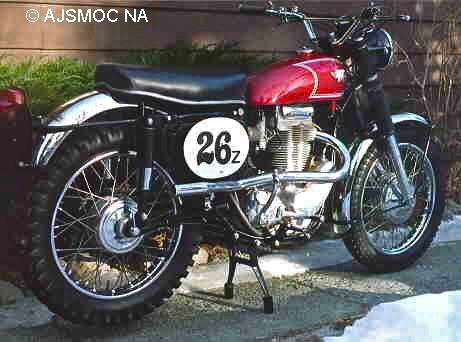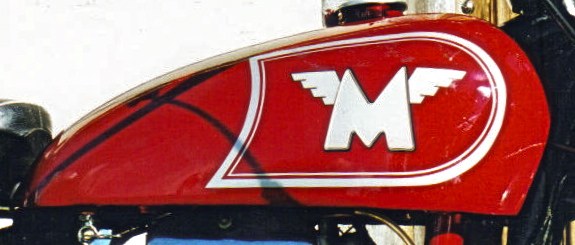1967 MATCHLESS G80CS BACKGROUND
The 500cc Matchless G80CS was a competition motorcycle aimed squarely at the US market where the model was arguably the one to beat in off-road events such as hare ‘n hounds, scrambles, desert races and enduros in the fifties and early sixties. It could never be described as a lightweight, as it was always rumoured that Matchless kept adding 3lbs of metal to the frame where it had broken in competition – until it stopped breaking. The result was the almost bullet-proof, highly reliable, late model G80CS which, in its final incarnation, weighed in at some 380lbs.

ABOVE: This was the image that sustained me during the long search for my bike and then again during its subsequent restoration. It belonged to Dave Campbell up in Alaska and is the perfect example of the model.
After searching in vain for 8 years in the UK for an affordable G80CS, I finally stumbled upon one advertised as a basket case in Walneck’s Classic Cycle Trader magazine while on a lengthy business trip to Seattle in 1998. Belonging to magazine proprietor Buzz Walneck himself, Buzz had bought it from the estate of the first and only owner. It had been dismantled many years before and had apparently been dry stored in the first owner’s basement ever since. I called Buzz in Illinois (1500 miles to the east) and asked him how complete the bike was. He told me that it was 98% all there. I then asked him if the engine would turn over and if there was compression? The answer was yes to both of these questions. Finally, I asked if gears could be selected – again, yes.
A couple of days later a set of photos arrived from Buzz that showed the dismantled G80CS in all its glory – underneath a thick crust of thirty year old mid-Western topsoil – and they are the ones in the first 55 seconds of the following video:

After taking a long deep breath I decided to buy it sight unseen. The bike might have been 98% all there – but was I? When I finally got to inspect the various parts upon its arrival in the UK, this is what I found: It had the correct competition engine (with Norton oil pump) with a scrambles cam; the engine & comp gearbox had matching numbers. It must have been run on alcohol as there was an 11.5:1 piston in it. In addition, there was a comp Lucas magneto, a left hand oil tank (try finding one of those today), a comp 2 gallon steel tank, a high level exhaust, extended front forks, ball end levers, knock off wheels & folding footrests. All the quickly detachable (q/d) parts were as new – the headlight, the rear light, silencer (muffler), chain guard, and the speedo (that showed only 603 miles on the clock). My initial plan had been to rebuild it myself but looking at the boxes of parts I realised I was in waay over my head. My bike ownership pattern had been intermittent – so as I wasn’t a long-time motorcyclist with a garage full of existing parts, spares and tools – and a fund of knowledge from previous restorations, I thought I’d get the job done by a professional – and I’d spread the pain (the cost) over a couple of years. A friend of mine with a Vincent Rapide, a pre-war Triumph Tiger 90 and a post-war Speed twin recommended a retired friend of his – a Matchless enthusiast with a workshop he could have built a small submarine in – who relished the opportunity to put this great bike together. He fitted new main bearings, a new big end, an 8.5:1 piston (to make it more suitable for road use), rewound the magneto, overhauled the gearbox, powder coated the frame and fitted 21″ front and 19″ rear wheels with s/s guards.

ABOVE: A closeup of the Del Orto carburetor.
Once I collected the rebuilt bike, I trailered it back home – and the moment of truth – the first ride! I’d not ridden a G80CS before – or even seen one in the flesh. To me the bike encapsulated all the things I liked in a motorcycle: it looked superbly functional with no need for ‘styling’, it had the best looking engine, tank and exhaust combination ever put together by man – plus it had that indefinable competition heritage – and it was a hot single. I also needed a tall bike – as I’m 6’2” – and fortunately I felt right at home when I threw a leg over it for the first time. It was fitted with ‘Western bars’ and I found these supremely comfortable.
I started it up and the deep pulsing note of the exhaust filled me with both confidence and anticipation. At last! I rode it to the next village (4 miles away) to post a letter and on starting it up again to return home, the revs suddenly rose and soared – way past where they should have been. I shut off the petrol supply and pulled the decompressor. I had to stop that newly rebuilt engine before it was damaged. In retrospect, I could have selected 4th gear and tried to stall it – but that was probably too risky. I let the bike cool down and started it again.. and the same thing happened again. I resigned myself to pushing the bike home. Our house was at the top of a long hill and I was breathing heavily (understatement of the year) when I finally pushed the bike into the garage. When my dearly beloved asked me what was wrong, I could hardly speak!
I removed the Amal 389 carb and drove up to Hitchcocks where they suggested a new carb body and a chrome slide – which did improve things a little but even then I was never able to achieve predictable starting and a satisfactory tickover. I subsequently changed one or two things from the original spec – 12v electrics via a new alternator and an AO Power Box, a 40mm Dell’Orto carb, a 21 tooth engine sprocket (vice 19 as per the original) and Hagon shocks. Finally I changed the colour of the tank to candy apple red and dispensed with the flimsy plastic tank badges in favour of the flying ^M^.
The bike is one of the very last of the illustrious line of Matchless competition singles to be made – it was manufactured in April ’67 before full-time production ceased a month later. Tall, slim, & functional, it was lent an additional massive presence by that beautiful all-alloy short stroke engine. It oozed charisma but not oil! (well, very little..) and had character in spades. With the original Amal 389 carb fitted, starting was always something of a lottery despite following the approved procedure. Starting from cold, I used to tickle the carb until petrol showed. I would then pull the exhaust valve lifter and turn the engine over a few times to fill the cylinder with mixture. Retarding the ignition a tad, I would then administer the traditional “long swinging kick”. It would usually start within 5 kicks – provided there wasn’t an audience! Anything after this caused my leg to grow weary due to the 8.5 piston so I would revert to a “run & bump” on a nearby hill.
Out of the blue, a colleague at work offered me a new Dell’Orto PHM40 carb at a price I could not resist. I wanted to fit the Dell’Orto in such a way that originality would not be compromised. I asked a friend if he could make up a new manifold that would allow the original Amal to be re-fitted if necessary. A skilled precision engineer, he did a superb job of machining a new manifold from solid alloy billet.
With the Dell’Orto now fitted, starting at last became reliable. The routine was then: petrol on, retard ignition a tad, open air lever a little if cold, give the twist grip a couple of turns to squirt some neat petrol into the cylinder, followed by 2-3 long slow strokes of the kick starter with the exhaust valve lifter lifted. Following the first serious kick, it usually boomed into life and settled down quickly to a slow even tick-over. Being honest, I’d say that the carb was probably too big for the bike – but only slightly. The clutch action was light (to me) and gear selection was fool-proof. Finding neutral was simply done. The engine smoothed out once the heavy flywheels were spinning and the faster the bike was ridden, the smoother it got. It sat comfortably at 60-65mph with snarling power instantly available beyond that. I had it up to 80mph for the odd brief period but wind pressure made life uncomfortable at that speed. Cruising at 60mph was far more preferable and sustainable. The exhaust note was a constant source of pleasure to me but some bystanders might have felt that its healthy crackle to be excessive by today’s standards.
There was a long downhill stretch nearby that I loved to finish my rides on. As I wound the big single up through the gears as the bike accelerated downhill, the engine note would change and I often tried to think of a suitable metaphor for the sound. I think the closest I ever got was ten circular saws ripping into ten teak logs..
A plodding Matchless single it wasn’t! The riding position suited me – the seat height was 33” and I didn’t feel cramped at all. As far as roadholding was concerned, potholes or white lines didn’t disturb its line through bends and it never once shook its head. I think that, in common with most other bikes of the same era, its braking ability was the only aspect of the bike that showed its age in the cut and thrust of modern traffic.
Best bike I ever had.
Check out these MATCHLESS BOOKS
Matchless, once the largest British motorcycle manufacturer
AJS and Matchless Post-War Singles and Twins: The Complete Story
Motorcycle Apprentice: Matchless – in name & reputation (Classic Reprint)
History of Matchless Motorcycles
BOOK OF THE MATCHLESS 350 & 500cc SINGLES 1955-1966
AJS and Matchless: The Post-war Models
AJS and Matchless Gold Portfolio 1945-1966
Illustrated Ajs and Matchless Buyer’s Guide (Illustrated Buyer’s Guide)












